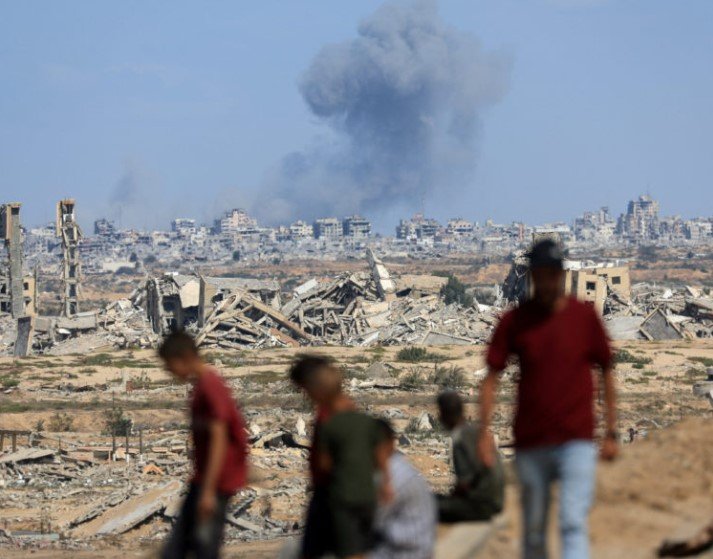Egypt has stepped up efforts to deploy up to 10,000 Palestinian security personnel in Gaza as part of the second phase of President Donald Trump’s peace plan. This move comes amid ongoing negotiations between Israel and Hamas, following a recent ceasefire and hostage exchanges, with talks focused on stabilizing the region after years of conflict.
Background on Trump’s Gaza Peace Plan
President Trump unveiled his 20-point peace plan last month, aiming to end the Gaza war that has dragged on for two years. The plan started with an immediate ceasefire and the release of hostages, which both sides have partly followed.
Now in its second phase, the plan shifts to governance and security. It calls for disarming Hamas, rebuilding Gaza, and setting up a transitional government under international watch. World leaders praised the initial steps, but many details remain unclear.
Support has come from countries like France, Germany, and the United Arab Emirates. Trump gave Hamas a short deadline to respond, warning of consequences if they refused. The plan leaves room for Palestinian statehood, but only if key conditions are met.
Details of Egypt’s Security Proposal
Egypt proposes starting with 1,000 trained Palestinian officers in Gaza to enforce security after the ceasefire. These personnel would get training in Egypt or Jordan before deployment.

The goal is to grow this force to 10,000 over time. They would handle daily security tasks, help with aid distribution, and maintain order in the Strip.
This fits into Trump’s vision of an international stabilization force led by Arab nations. Egypt wants to avoid looking like an occupier, so the force would be Palestinian led but with outside support.
- Initial deployment: 1,000 officers focused on border control and public safety.
- Expansion plan: Up to 10,000 within months, depending on talks.
- Training sites: Mainly in Egypt and Jordan for quick readiness.
Egyptian President Abdel Fattah el-Sisi discussed this with Trump during a summit in Sharm El-Sheikh on October 13. The meeting highlighted Egypt’s role as a mediator in the region.
Challenges Facing the Deployment
Israel has shown resistance to a large armed Palestinian presence in Gaza. Officials worry it could strengthen groups like the Palestinian Authority, which they see as a threat.
Arab countries hesitate too. They fear getting stuck in a long-term role that might spark local backlash. Logistical hurdles include who controls borders and how to disarm militants without new violence.
Hamas rejected some early terms, like full demilitarization. Negotiators say these issues could delay progress, but steady talks offer hope.
Recent events add complexity. A surprise Israeli attack in March restarted fighting after brief ceasefires. Now, with hostages returning, both sides must build trust.
Progress in Hostage Exchanges and Aid
The first phase saw Hamas release 20 living hostages and some bodies. Israel freed Palestinian prisoners in return, marking a key milestone.
Aid flows have increased, with 600 trucks entering Gaza daily through the Kerem Shalom crossing. This helps ease the humanitarian crisis, where food and medical shortages have hit hard.
| Key Exchanges So Far | Details |
|---|---|
| Hostages Released | 20 living Israelis, plus 7 bodies (one misidentified) |
| Prisoners Freed | 45 Palestinians in exchange for 3 deceased hostages |
| Aid Trucks Daily | Up to 600, carrying food, medicine, and supplies |
| Next Steps | More remains transfers expected this week |
Recovery teams from Egypt and Turkey are searching based on Israeli data. The Rafah crossing remains closed, giving Israel leverage in talks.
These steps show the plan is moving forward, even if slowly. Officials say full implementation could take months.
International Reactions and Next Steps
Global leaders have mixed views. Some see Trump’s plan as a bold move, while others call for more diplomatic push to avoid old conflicts returning.
Russia and the UK back the effort, but stress the need for lasting peace. In the US, Trump touts it as a win, saying rebuilding can now begin.
For Gaza residents, this means hope for normal life. Yet, without agreement on governance, risks remain high.
Outlook for Lasting Peace
Experts predict tough negotiations ahead on who runs Gaza long term. Trump’s plan includes a development fund for reconstruction, but funding details are vague.
If successful, this could lead to Palestinian self rule. Failure might restart fighting, undoing recent gains.
The second phase tests if all sides can compromise. With Egypt leading on security, the region watches closely.
What do you think about Egypt’s role in these talks? Share your views in the comments and spread the word to keep the conversation going.
